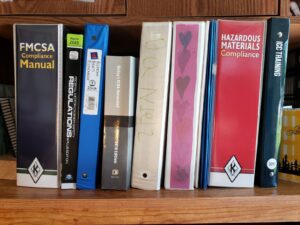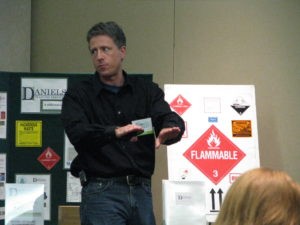Federal regulations of the U.S. Environmental Protection Agency (USEPA) at 40 CFR 262.17(a)(6) require a large quantity generator of hazardous waste (LQG) to comply with the preparedness, prevention, and emergency procedure standards of 40 CFR 262, subpart M. This article is the eighth in a series that looks closely at each of the sections in subpart M to clearly describe the responsibilities of a LQG.
The purpose of this article is to address the requirements of 40 CFR 262.260 Purpose and implementation of contingency plan.
Before we begin…
These regulations were revised by the Generator Improvements Rule. If your state has not yet adopted the new rule you must continue to comply with the earlier version until it does. You may read an article explaining the earlier version of the regulations (prior to implementation of the Generator Improvements Rule) here.
You may notice the earlier version of these regulations (prior to the Generator Improvements Rule) included a section prior to this one identifying the applicability of the contingency plan and emergency procedures to a LQG. Read: The Requirements of 40 CFR 265.50 Applicability for Large Quantity Generators of Hazardous Waste. This particular section is not found in the revised regulations because the applicability for all of the preparedness, prevention, and emergency procedures for a LQG were identified and described at 262.250. Read: The Requirements of 40 CFR 262.250 Applicability of Preparedness, Prevention, and Emergency Procedures for Large Quantity Generator of Hazardous Waste.
|
Not sure of your hazardous waste generator status? |
Scope and Applicability:
These regulations are applicable to a LQG. A small quantity generator of hazardous waste (SQG) is subject to entirely different requirements for emergency response. If you are a SQG please refer to this article for your version of these regulations: Preparedness, Prevention, and Emergency Procedures for Small Quantity Generator of Hazardous Waste. (Some of these article are not yet written. Please be patient.)
As made clear by §262.250 (revised by the Generator Improvements Rule), the preparedness, prevention, and emergency procedures of Subpart M are applicable to those areas of a LQG where hazardous waste is generated or accumulated. This includes:
- Central Accumulation Area (CAA)
- Satellite Accumulation Area (SAA)
Read: Applicability of Preparedness, Prevention, and Emergency Procedures for LQG
40 CFR 262.260 reads:
(a) A large quantity generator must have a contingency plan for the facility. The contingency plan must be designed to minimize hazards to human health or the environment from fires, explosions, or any unplanned sudden or non-sudden release of hazardous waste or hazardous waste constituents to air, soil, or surface water.
(b) The provisions of the plan must be carried out immediately whenever there is a fire, explosion, or release of hazardous waste or hazardous waste constituents which could threaten human health or the environment.
Why the change?
No change of any significance, really. A reference to, “Each owner or operator…” in the opening sentence was replaced with, “A large quantity generator…” This indicates the applicability of these regulations solely to a LQG. Elsewhere the masculine pronoun “his” was replaced with a neutral “the” (I mean, c’mon. It’s 2017!)
|
Interested in site specific training at your site that covers this topic, and more! Ask me about my Onsite Training |
“A large quantity generator…”
As noted earlier in this article and as established in §262.250, these regulations apply solely to a LQG.
“…must have a contingency plan…”
Contingency plan is defined at §260.10:
Contingency plan means a document setting out an organized, planned, and coordinated course of action to be followed in case of a fire, explosion, or release of hazardous waste or hazardous waste constituents which could threaten human health or the environment.
The requirement is for a document, not just procedures known to all. The contingency plan must identify an organized, planned, and coordinated response to certain identified emergencies. The type of emergencies listed in the definition of contingency plan are the same as those identified in §262.260 and described later in this article.
“…designed to minimize hazards…”
The purpose of the plan – its design – is to minimize the hazard to both of the following:
- Human health. Not just hazardous waste personnel, not just the employees of the LQG, but the health of all persons within and without the facility.
- The environment. Note the lack of a specific reference to air, water, or soil; just, “the environment”. Like the previous directive it is vague enough to apply to almost anything within or without the facility.
“…from…to…”
Here the regulations become specific – and very broad – and list the emergencies for which the contingency plan is designed:
- Fires
- Explosions
Or…
- An unplanned (i.e., unexpected) release to any of the following:
- Air
- Soil
- Surface water
- Of either of the following:
- Hazardous waste. The identified hazardous waste(s) generated at your facility.
- Hazardous waste constituent. Any chemical or element that is or was part of a hazardous waste.
- When the release is either of the following:
- Sudden. Takes place within a short period of time.
- Non-sudden. The release may have been a slow leak taking place over a long period of time of which you just became aware.
“…carried out immediately…”
This is key to the contingency plan and illustrates USEPA’s requirement that it not be a document gathering dust on some shelf. The provisions of the plan (described in §262.265) must be immediately implemented in the event of any of the above emergencies. The contingency plan must document the steps the facility will take to respond to those emergencies and the role of facility personnel – and outside emergency responders – if one were to occur.
Q: How much time do I have before my response to an emergency is no longer considered to be, “…carried out immediately…”?
A: From RO 12748: “The Environmental Protection Agency (EPA) has not established a definition of what constitutes an immediate response to a spill situation. The time frames and extent of immediate response must be judged by persons responding to discharges on an individual basis (emphasis mine). Extended responses which are not judged to be immediate in nature may result in: (1) a modification to the facility’s contingency plan; (2) an enforcement action for an inadequate contingency plan or permit violation; or (3) enforcement action for illegal disposal.”
|
Contact me the next time hazardous waste generator USEPA training is due to expire. |
Is that it?
No. First of all, as an LQG you must still comply with the remaining requirements of §262, subpart M which have been moved from their former location at §265, subpart D and were revised by the Generator Improvements Rule.
And then, what about training? At §262.17(b)(7) – directly following the referral to emergency procedures – are the training requirements for a LQG. §262.17(b)(7)(i)(C) reads in part:
At a minimum, the training program must be designed to ensure that facility personnel are able to respond effectively to emergencies…
So clearly, Hazardous Waste Personnel Training at a LQG is important.


